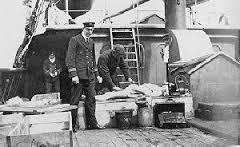The Recovery
/Clifford Crease had just celebrated his 24th birthday aboard the C.S. Mackay-Bennett, where he worked as a craftsman-in-training. The ship was one of several laying cable between the US and Europe when the Titanic sank on April 15, 1912. While the RMS Carpathia was on the way to New York with the survivors, the White Star Line chartered the Mackay-Bennett and three other ships to assist with the recovery of any bodies from the wreck site.
The C.S. Mackay-Bennett
Carrying a minister, an undertaker, and a load of caskets and embalming supplies, the Mackay-Bennett left her port in Halifax, Nova Scotia on April 17, two days after the sinking. Clifford Crease, along with most of the crew, offered to do whatever was needed. When the ship reached the area where the Titanic sank, far more bodies were visible than the ship’s captain had anticipated. The three other ships involved in the recovery met with the Mackay-Bennett to transfer additional supplies for the bodies.
Caskets and an unidentified body aboard the Mackay-Bennett
In his diary, Clifford Crease wrote of assisting with the grim task. He described his role in spotting and recovering the body of a small boy, which the crew referred to as “our babe.” They placed a brass marker inside his casket with those words. Later, Crease made sure the boy was given a proper burial and grave marker, although his identity remained a mystery. He visited the grave every year until his death in 1961 and was buried nearby.
Out of the 306 bodies found at the site, 156 were buried at sea due to extreme injuries or decomposition. Only 56 of them were identified. On board the Mackay-Bennett for return to Halifax were 190 bodies, almost twice as many as there were caskets. Those without caskets were wrapped in tarps. In Halifax, 40 of the bodies were claimed by relatives, and 150 were buried in the city’s Fairview Lawn Cemetery. Today, many still visit the graves and the Maritime Museum of the Atlantic, where the stories live on of those involved in the recovery. Clifford Crease's diary and the shoes of the "unknown child" are among the artifacts.
In 2002, several bodies were exhumed at the cemetery, in order to conduct DNA testing and make identification. Inside the unknown child’s casket, the brass marker with the words, “our babe” had protected a bone with enough DNA to test. He was identified as 19-month-old Sidney Leslie Goodwin, whose parents and five siblings also died in the sinking. The family had been on the way to Niagara Falls, due to a job offer for Mr. Goodwin.
Sidney Goodwin



